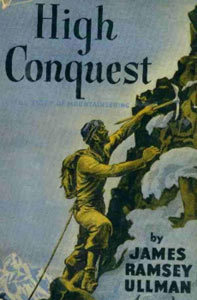
Many climbers have a favorite mountaineering book or essay. Athletes and guides, those whose lives are so deeply connected to climbing, often have literary obsessions–and everything from a story’s lyricism to its ethical stance has influenced how they approach the sharp end.
We at Alpinist picked a handful of climbers we found inspirational and asked them to share their literary influences. Read Vince Anderson’s take on The Satanic Bible in the January 2, 2008 Weekly Feature; Kelly Cordes and Masatoshi Kuriaki’s take on High Alaska in the January 30, 2008 Weekly Feature; Simon Richardson’s chapter on Gervasutti’s Climbs in the February 6, 2008 Weekly Feature.
Royal Robbins on High Conquest, by James Ramsey Ullman
The climbing book that had the strongest influence on me was High Conquest by James Ramsey Ullman, written in 1942. I was very affected by other books, such as First on the Rope by the Frenchman, Frison-Roche, as well as the writings of Clarence King and John Muir, but High Conquest was pivotal.

Royal Robbins climbing at age 15, Stoney Point, San Fernando Valley, California. Robbins was smitten with rock climbing as a youngster, interested by a Boy Scout trip to the High Sierra and the books he sought afterward. Of the image, Robbins writes: “I am only a couple feet off the ground, but it seems clear that I am trying to look like my hero in the picture from High Conquest.” [Photo] Royal Robbins collection
I first came upon the book at age 15 when I was in the Los Angeles Public Library searching the shelves for books on mountain climbing. I had been introduced to the sport/craft/way of life on a Boy Scout trip to the High Sierra. I was quite taken by climbing and wanted to learn more about it. Ullman’s book intrigued, so I checked it out, took it home, and got lost in it. It’s basically a history of mountaineering, but its most salient point is that the “high conquest” of the title is not truly getting to the top of the highest peaks; it’s the conquest of those weak and timid parts of ourselves we don’t want running the show. I don’t know who has these elements traipsing around their psyche, but I know I had my share, and the idea of using mountain climbing to rise above them was very appealing.
Ullman is a masterful writer, and it is significant that he is one of America’s best climbing writers, but though a man of wide climbing experience, he didn’t make his name by what he did, but rather by what he wrote. In High Conquest, he chronicles the ascents of many of the world’s peaks, including the Matterhorn, Mont Blanc and Denali, to name a few. At that time Everest had not yet been climbed, but Ullman predicted it would be. And he tells of Mallory and Irvine’s magnificent effort high on the world’s tallest mountain before they were lost forever in 1924.
This book is a ringing declaration of the glory of mountain climbing. On the title page is a quote from George Leigh-Mallory: “Have we vanquished an enemy? None but ourselves.” If this book were reduced to two sentences, those would suffice. And Ullman finishes with his own soaring coda: “It is not the summit that matters, but the fight for the summit; not the victory, but the game itself.”
In the book is a photograph of a climber on a steep rock face with a memorable caption: “HARD ROCK–THIN AIR–A ROPE”. He appears to be in an extreme situation, but he looks at home. He seems to be in charge. When I saw that picture I said to myself, “That’s what I want to be. I want to be a climber.” Ullman’s prose and that picture captured my heart. And so, I gave my heart to mountain climbing.
Keep on Climbing,
–Royal Robbins, Modesto, California

Robbins’s favorite page of High Conquest. This image inspired the soon-to-be legend; it is of the same climber Robbins is emulating in the photo above. [Photo] Royal Robbins collection